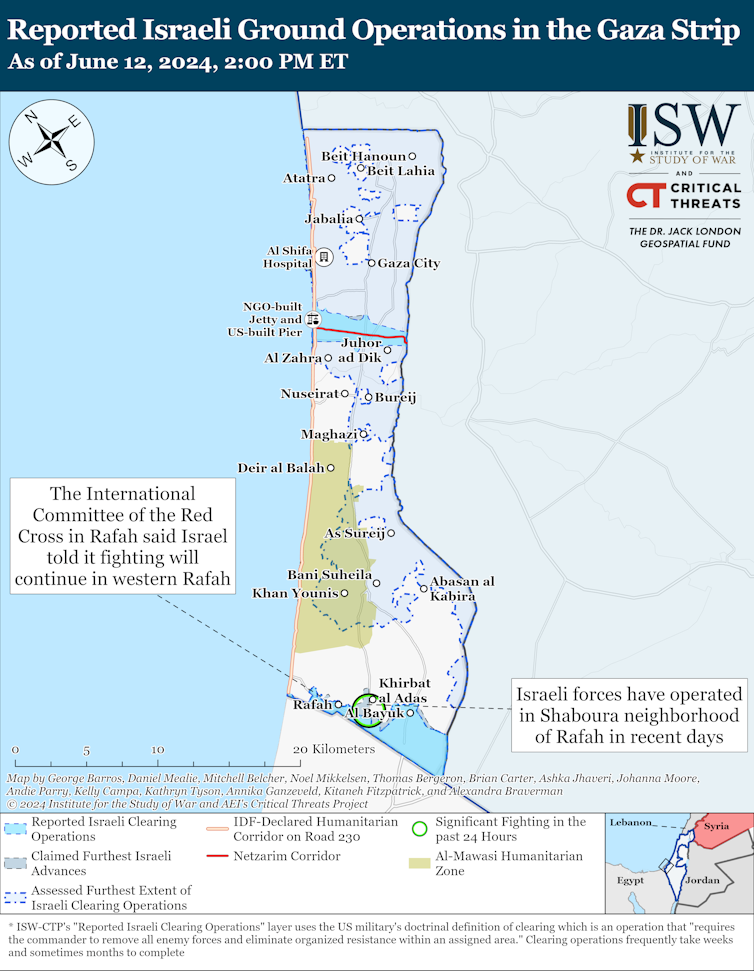When the UN security council voted in favour of a resolution backing the latest ceasefire deal for Gaza on June 10, the only member state to abstain was Russia. It did so, it said, because of insufficient assurances that Israel would abide by the deal’s terms. China supported the resolution, but doubted whether there had been notable developments since the previous ceasefire motion. The other 13 states were supportive if not overly optimistic.
Whether progress is now made depends on several factors. Prominent among these are how the war goes from here, the Israeli political environment and the extent of pressure on Israel from the Washington for a ceasefire.
The four hostages released by Israeli forces were certainly welcomed home to Israel but the remarkable element in their release was that they were in good physical health. This was after eight months of captivity in an intense war zone and suggests that Hamas is very far from defeat if it can maintain that degree of organisation for so long when faced persistently with overwhelming firepower.
It is one more sign that Hamas is proving far more resilient than the Israel Defence Forces (IDF) or Israeli intelligence and security agencies expected.
Much of Gaza has been reduced to little more than rubble, at least 37,000 Palestinians have been killed, according to the Gaza Health Ministry, including more than 15,000 children. Another 10,000 people are missing, over 80,000 have been injured, and the World Health Organization is reporting 8,000 children currently with symptoms of acute malnutrition.
Universities, schools, hospitals, water treatment plants, public services and buildings have been wrecked, yet Hamas is persistently reasserting itself in parts of Gaza that have previously been occupied by the IDF. Hamas may have had huge losses of its own, but it is becoming clear that it has not been defeated. And this is having serious consequences for Netanyahu’s government.
Taking the bait
From the start of the Israeli response to the October 7 atrocities, there was a risk that the IDF was falling into a trap of Hamas’s making. Given the skill of Hamas’s preparations and the ability to maintain high levels of security until the day of the attack, there was a strong probability that the Hamas planners had thought the whole thing through. Moreover, this would have included planning for multiple scenarios, most of them no doubt focused on a very strong Israeli retaliation.
Remember that barely three weeks into the war, some analysts were already pointing to the dangers for Israel of embarking on a ground invasion. By early November, much international opinion outside the west had moved markedly against Israel in the wake of the intensive bombing of urban areas and the rapidly rising death toll. Despite this mood, which increasingly spread to northwards as it became more difficult to disrupt the Hamas paramilitaries, the IDF made more intensive use of the Dahiya doctrine.
That term had first been used after the war in Lebanon in 2006 but the approach goes right back to the occupation of southern Lebanon in 1982 and of the risks of engaging in counter-guerrilla warfare. Put bluntly, Israeli ground forces would invariably take serious casualties if engaged against determined and combat-experienced paramilitaries fighting on their own territory.

That was especially so if that territory was an urban environment, so a response was rooted in the collective punishment of civilians, and this came rapidly to dominate IDF behaviour. The aim may have been to undermine civilian support for the insurgents, but inevitably Palestinian casualties went through the roof.
Young victims
Even the freeing of the hostages fits into this pattern. Four Israelis were successfully freed, but at the cost of the intensive bombardment of a densely populated refugee camp, the deaths of up to 274 Palestinians and the injuring of many hundreds more. For many observers what makes it worse is the high proportion of children among those killed and injured.
Throughout the eight-month war, children have been massively affected, so much so that a UN report due to be presented to the general assembly this week states that: “Israel and the Occupied Palestinian Territory presents an unprecedented scale and intensity of grave violations against children”. There were more violations against children in Gaza, the West Bank and Israel than anywhere else in the world last year, the report says.
The Israeli government reacted angrily to the report. The prime minister, Benjamin Netanyahu, said the UN had “added itself to the blacklist of history when it joined those who support the Hamas murderers”. There has been a similar response to a further UN report accusing Israel as well as Hamas of war crimes.
Israel is now trapped in an intensely violent stalemate. In the face of this, Biden’s current proposal is for a three-phase transition to a settlement, starting with a long ceasefire to allow negotiations to proceed. Perhaps progress can be made but there is considerable doubt among close observers of Israeli politics that Netanyahu has any intention of seeing an end to the war in the next few months.
On the Palestinian side, there are certainly some differences between the Hamas military leadership in Gaza and the overall political leadership in Qatar. But Israeli actions in the occupied West Bank, especially persistent violence against Palestinians by Israeli settlers and the IDF, mean more support for Hamas and confidence in its ultimate success.
Given the predicament that Netanyahu is now in what will be uppermost in his mind will be the US election in November and the chance of Donald Trump returning to the White House, giving him far more of a blank cheque in terms of US support for his government.
There desperately needs to be a swift end to the fighting. But it is much more likely that this appalling war has many more months to run.

